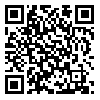Volume 12, Issue 3 (Summer 2024)
PCP 2024, 12(3): 217-230 |
Back to browse issues page
Download citation:
BibTeX | RIS | EndNote | Medlars | ProCite | Reference Manager | RefWorks
Send citation to:



BibTeX | RIS | EndNote | Medlars | ProCite | Reference Manager | RefWorks
Send citation to:
Gholamrezaei H, Falsafinejad M R, Khodabakhshi-Koolaee A. Exploring the Dimensions of Online Child Sexual Abuse: A Qualitative Meta-synthesis Study. PCP 2024; 12 (3) :217-230
URL: http://jpcp.uswr.ac.ir/article-1-924-en.html
URL: http://jpcp.uswr.ac.ir/article-1-924-en.html
1- Department of Counseling, Faculty of Humanities and Social Sciences, North Tehran Branch, Islamic Azad University, Tehran, Iran.
2- Department of Assessment and Measurement, Faculty of Psychology and Educational Sciences, Allameh Tabataba’i University, Tehran, Iran ,falsafinejad@yahoo.co.uk
3- Department of Psychology and Educational Sciences, Faculty of Humanities, Khatam University, Tehran, Iran.
2- Department of Assessment and Measurement, Faculty of Psychology and Educational Sciences, Allameh Tabataba’i University, Tehran, Iran ,
3- Department of Psychology and Educational Sciences, Faculty of Humanities, Khatam University, Tehran, Iran.
Abstract: (2565 Views)
Objective: With the expanded use of the Internet, online child sexual abuse has been facilitated through the growing number of malicious websites that allow criminals to interact with children. Online child sexual abuse involves acquiring, displaying, collecting, and distributing sexual content to obtain sexual satisfaction from a child. Online child sexual abuse threatens the public mental health of society through its adverse effects on the mental health of children and families. To this end, the present study aims to review the studies on online sexual abuse to provide a comprehensive picture of this phenomenon.
Methods: This study was conducted with a qualitative and systematic review method. The research population was 113 articles published in scientific databases in the last decade about online sexual abuse and its dimensions. The research sample consisted of 22 articles, which were selected based on thematic monitoring and theoretical saturation of data via purposive sampling. The data were collected from a qualitative analysis of the studied documents and records.
Results: Data analysis revealed that indicators of online child sexual abuse are divided into 4 dimensions, 9 categories, and 56 subcategories, including knowledge components (low cyber knowledge, unawareness of the boundaries of online activities, low media literacy), psychological components (intrapersonal, interpersonal, personality, and interactive factors), approach-based components (cyberbullying, intimacy, and sexual-emotional abuse), and environmental components (cyberspace features and distribution platforms).
Conclusion: Paying attention to the virtual environment for learners leads to the reduction of the existing injuries in this environment. Identifying the indicators and components of online sexual abuse of children allows educational leaders and those involved in virtual space to examine online sexual abuse from various dimensions.
Methods: This study was conducted with a qualitative and systematic review method. The research population was 113 articles published in scientific databases in the last decade about online sexual abuse and its dimensions. The research sample consisted of 22 articles, which were selected based on thematic monitoring and theoretical saturation of data via purposive sampling. The data were collected from a qualitative analysis of the studied documents and records.
Results: Data analysis revealed that indicators of online child sexual abuse are divided into 4 dimensions, 9 categories, and 56 subcategories, including knowledge components (low cyber knowledge, unawareness of the boundaries of online activities, low media literacy), psychological components (intrapersonal, interpersonal, personality, and interactive factors), approach-based components (cyberbullying, intimacy, and sexual-emotional abuse), and environmental components (cyberspace features and distribution platforms).
Conclusion: Paying attention to the virtual environment for learners leads to the reduction of the existing injuries in this environment. Identifying the indicators and components of online sexual abuse of children allows educational leaders and those involved in virtual space to examine online sexual abuse from various dimensions.
Type of Study: Review paper |
Subject:
Rehabilitation
Received: 2023/12/15 | Accepted: 2024/02/12 | Published: 2024/07/1
Received: 2023/12/15 | Accepted: 2024/02/12 | Published: 2024/07/1
| Rights and permissions | |
 |
This work is licensed under a Creative Commons Attribution-NonCommercial 4.0 International License. |







